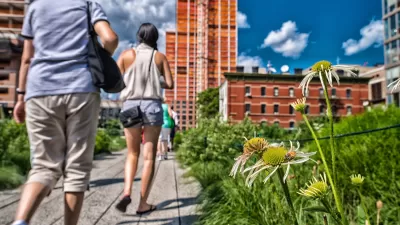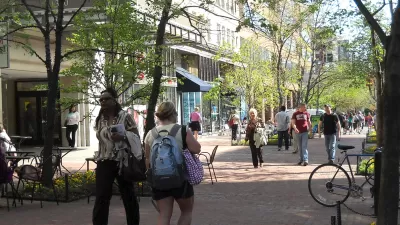Cities are putting together the pieces of walkability, but there's still work to be done in completing the puzzle.

Laura Laker writes a feature story on how cities are making their cities more walkable, and why:
The modern obsession with autonomous and electric vehicles, dockless scooters and bicycles means it is easy to forget the humble pedestrian. However, as almost every journey starts or finishes on foot, we are ignoring a fundamental part of what makes a city great.
To gather the evidence for the story, Laker surveys representatives from organizations like the UK walking charity Living Streets, the design and planning company Arup, and the National Association of City Transportation Officials (Nacto).
The article goes into detail on case studies from Auckland, London, Manchester, Hanoi, Denver, Addis Ababa, and San Francisco. One particularly compelling anecdote from these case studies:
Notoriously car-centric Auckland in New Zealand recently published a report showing pedestrians as the most economically important transport mode in the city. They estimated that policies which put people off walking on Queen Street, a major shopping area, cost NZ$11.7m (£5.9m) a year.
While there are many examples of cities working hard to improve safety for pedestrians, and from numerous approaches the many risks facing pedestrians, Laker makes one thing abundantly clear: there's still along way to go and cities will require a lot of strong leadership to make dreams of a truly walkable city come true.
FULL STORY: What would a truly walkable city look like?

Planetizen Federal Action Tracker
A weekly monitor of how Trump’s orders and actions are impacting planners and planning in America.

San Francisco's School District Spent $105M To Build Affordable Housing for Teachers — And That's Just the Beginning
SFUSD joins a growing list of school districts using their land holdings to address housing affordability challenges faced by their own employees.

The Tiny, Adorable $7,000 Car Turning Japan Onto EVs
The single seat Mibot charges from a regular plug as quickly as an iPad, and is about half the price of an average EV.

As Trump Phases Out FEMA, Is It Time to Flee the Floodplains?
With less federal funding available for disaster relief efforts, the need to relocate at-risk communities is more urgent than ever.

With Protected Lanes, 460% More People Commute by Bike
For those needing more ammo, more data proving what we already knew is here.

In More Metros Than You’d Think, Suburbs are Now More Expensive Than the City
If you're moving to the burbs to save on square footage, data shows you should think again.
Urban Design for Planners 1: Software Tools
This six-course series explores essential urban design concepts using open source software and equips planners with the tools they need to participate fully in the urban design process.
Planning for Universal Design
Learn the tools for implementing Universal Design in planning regulations.
Smith Gee Studio
City of Charlotte
City of Camden Redevelopment Agency
City of Astoria
Transportation Research & Education Center (TREC) at Portland State University
US High Speed Rail Association
City of Camden Redevelopment Agency
Municipality of Princeton (NJ)





























